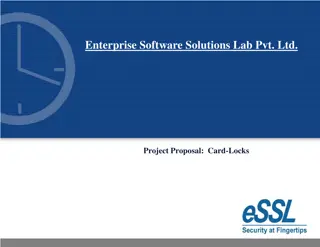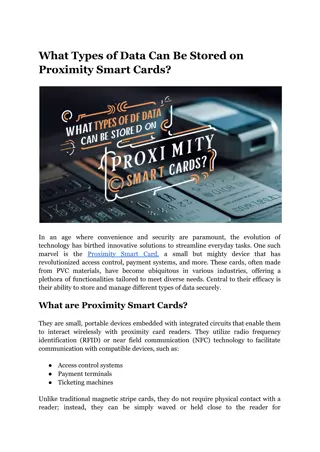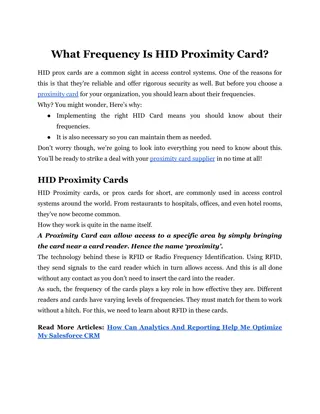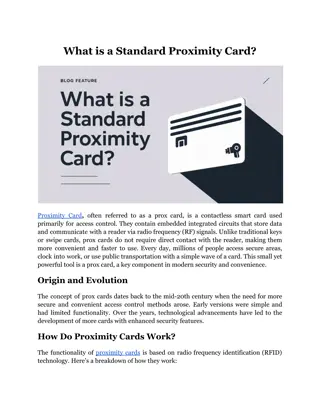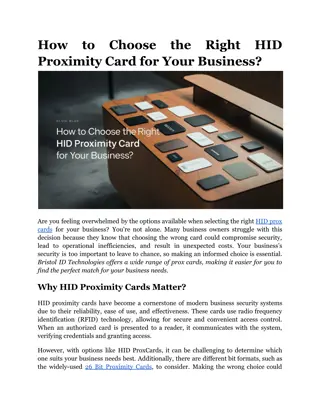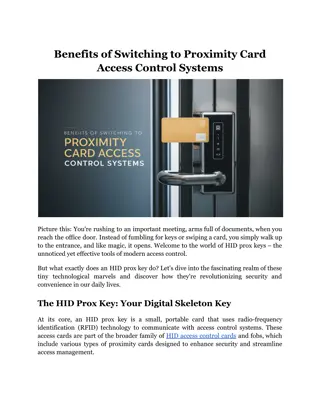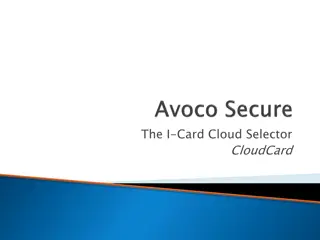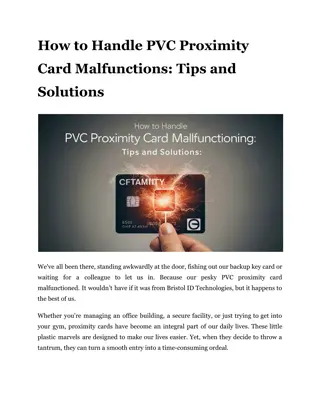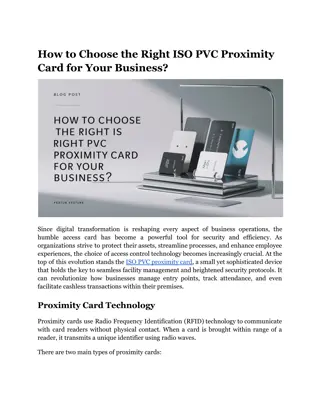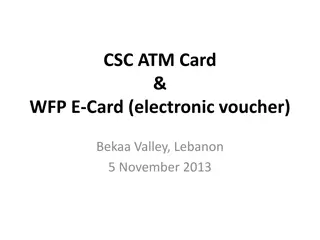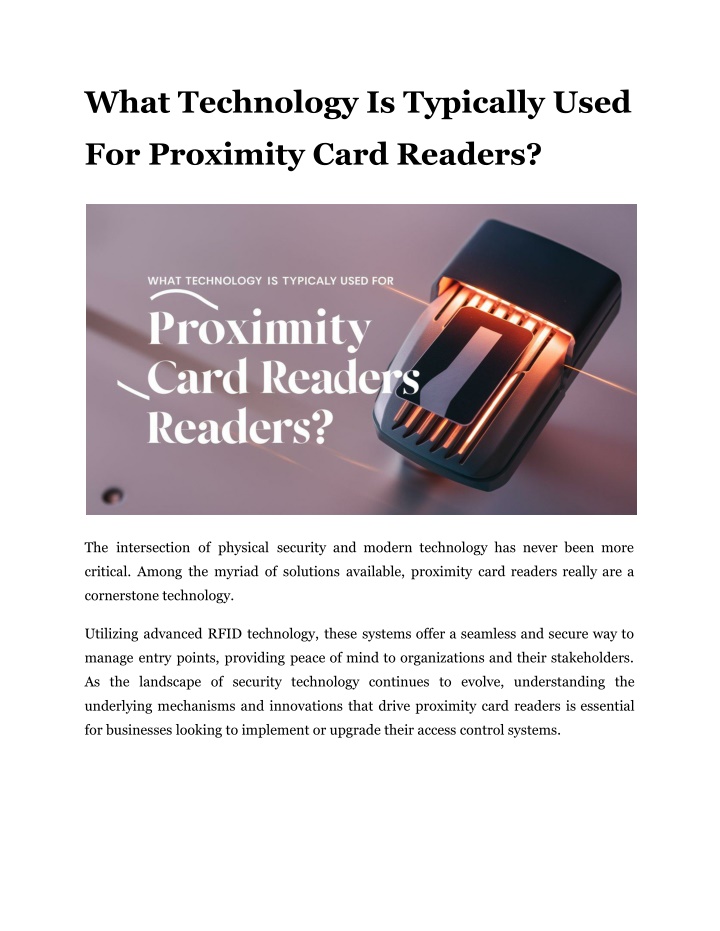
What Technology Is Typically Used For Proximity Card Readers?
Discover the key technologies behind proximity card readers. Learn how they work and what makes them secure and reliable.
Download Presentation

Please find below an Image/Link to download the presentation.
The content on the website is provided AS IS for your information and personal use only. It may not be sold, licensed, or shared on other websites without obtaining consent from the author. If you encounter any issues during the download, it is possible that the publisher has removed the file from their server.
You are allowed to download the files provided on this website for personal or commercial use, subject to the condition that they are used lawfully. All files are the property of their respective owners.
The content on the website is provided AS IS for your information and personal use only. It may not be sold, licensed, or shared on other websites without obtaining consent from the author.
E N D
Presentation Transcript
What Technology Is Typically Used For Proximity Card Readers? The intersection of physical security and modern technology has never been more critical. Among the myriad of solutions available, proximity card readers really are a cornerstone technology. Utilizing advanced RFID technology, these systems offer a seamless and secure way to manage entry points, providing peace of mind to organizations and their stakeholders. As the landscape of security technology continues to evolve, understanding the underlying mechanisms and innovations that drive proximity card readers is essential for businesses looking to implement or upgrade their access control systems.
The Proximity Card Technology Proximity card technology, also known as contactless smart card technology, has revolutionized the way we approach access control and security. These systems use radio frequency identification (RFID) to communicate between a card or tag and a reader, allowing for quick and convenient access without the need for physical contact. Read More Articles: How Do I Know What Type of Proximity Card I Have? Key Technologies in Proximity Card Readers RFID Technology How It Works: RFID technology uses electromagnetic fields to automatically identify and track tags attached to objects. In the context of proximity card readers, each card contains a chip and antenna that communicate with the reader when nearby. Types of RFID: There are two main types of RFID systems: passive and active. Passive RFID tags do not have their own power source and rely on the reader's signal to activate. Active RFID tags, on the other hand, have their own power source and can transmit signals over longer distances. Magnetic Stripe Technology While not as common in proximity readers, magnetic stripe technology is still used in some access control systems. Magnetic stripes require physical contact with the reader, making them less convenient than RFID systems. Biometric Technology Biometric systems, such as fingerprint or facial recognition, can complement proximity card systems but are not typically used as standalone technologies for access control.
Infrared Technology Infrared technology is also not commonly used in proximity card readers. It is more often found in remote controls and certain types of data transmission. Magnetic Stripe Biometric Technology Feature RFID Technology Contact Required No Yes No Speed Access of Fast Moderate Fast High encryption) (with Security Level Moderate High Durability High Moderate High Cost Moderate Low High How Proximity Card Readers Work At its core, a proximity card reader system consists of three main components: 1. The proximity card or tag 2. The card reader 3. The access control system When a user presents their proximity card to the reader, the reader emits a low-power radio frequency field. This field energizes a small antenna embedded within the card, which then transmits a unique identification code back to the reader. The reader decodes this information and sends it to the access control system, which determines whether to grant or deny access based on predefined permissions. Further Types of Proximity Card Technologies There are several types of proximity card technologies in use today, each with its own strengths and applications. Let's explore some of the most common:
1. Low-Frequency (LF) RFID Low-frequency RFID systems typically operate at 125 kHz or 134.2 kHz. These systems are widely used in access control applications due to their reliability and cost-effectiveness. Pros Cons Well-established technology Relatively inexpensive Good performance surfaces Limited read range (usually up to 10 cm) Lower data transfer rates Less secure compared to newer technologies near metal 2. High-Frequency (HF) RFID High-frequency RFID systems operate at 13.56 MHz and offer improved performance over LF systems. Pros Cons Faster data transfer rates Better read range (up to 1 meter) Enhanced security features More expensive than LF systems May have interference issues with some metal surfaces 3. Ultra-High Frequency (UHF) RFID UHF RFID systems operate in the 860-960 MHz range and offer the longest read ranges of all RFID technologies. Pros Cons Extended read range (up to 12 meters) High data transfer rates Ability to read simultaneously More expensive than LF and HF systems Can be affected by liquids and metals May raise privacy concerns due to the long read range multiple tags
Types of Proximity Cards HID Prox Cards HID Global is a leading proximity card supplier known for its high-quality products. HID prox cards are widely used in various industries for secure access control. HID ProxCard II: This card is a standard in the industry, featuring a durable design and compatibility with most proximity card readers. HID card operates at a frequency of 125 kHz and is known for its reliability. Proximity Cards The term "26 Bit Proximity Cards" refers to a specific format used in RFID systems. These cards encode data in a 26-bit format, which is a standard for many access control systems. This format allows adequate security for most applications. Read More Articles: Australia's Oldest Winery: The Story of Wyndham Estate Selecting the Perfect Partner: Proximity Card Suppliers You Can Trust Product Range: Look for a supplier offering a variety of prox card options, including Prox Card II HID and potentially 26-bit solutions. Customization Options: Does the supplier offer custom printing or encoding for your prox cards? This can be vital for branding or pre-loading access permissions. Compatibility: Ensure the supplier's cards are compatible with your existing proximity card reader system. Technical Support: Reliable technical support is crucial for troubleshooting any issues that might arise. Security Certifications: Choose a supplier that prioritizes security and adheres to industry standards for data protection.
Experience and Reputation: Opt for a well-established supplier with a proven track record in the access control industry. Invest in Convenience and Security Proximity card technology has come a long way since its inception, offering increasingly sophisticated solutions for access control and security as you consider implementing or upgrading your access control system, partner with a knowledgeable proximity card supplier. You need someone who can guide you through the selection process and help you choose the right technology for your specific requirements. Bristol ID Technologies introduces you to the various HID ProxCard 2 and more options available and designs a custom solution that meets your unique needs. Learn more about how proximity card technology can revolutionize your access control system! Site Article: What Technology Is Typically Used For Proximity Card Readers?

